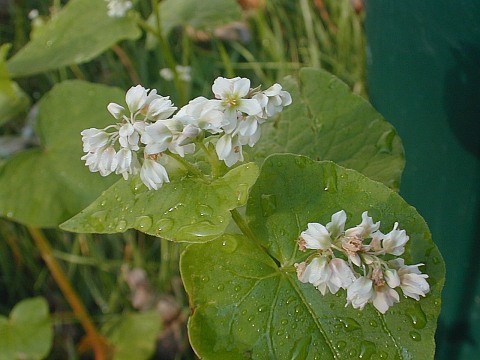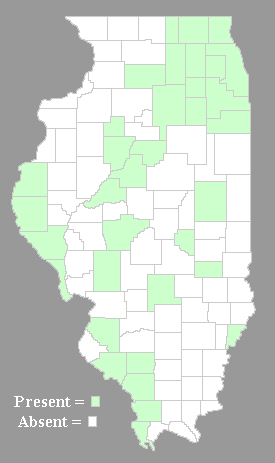Description: This annual plant is ½–2½' tall, branching occasionally. It is more or less erect, but has a tendency to sprawl in the absence of supportive vegetation. The stems become ribbed and reddish green with maturity, otherwise they are light green and round. The alternate leaves are up to 4" long and 3" across. They are sagitate or cordate, indented at the base, and often tapering abruptly above the middle. Their margins are smooth or slightly undulate. The lower leaves have slender petioles, while the upper leaves are sessile. Usually, neither the stems nor the leaves are hairy, although the upper stems are hairy on some cultivars.

One or two racemes
of flowers develop from the axils of the upper leaves; some of these
racemes may be terminal. These racemes are 1-3" long, and they are
densely crowded with whorls of flowers. Each flower is up to ½" across,
consisting of 5 petal-like sepals, 8 white stamens with pink anthers, a
tripartite white style, and no petals. The sepals are white, sometimes
becoming green toward the throat of the flower. The outer surface of
the sepals is occasionally tinted light pink, particularly on the
flowerbuds. The blooming period occurs during the summer and lasts 1-3
months. There is a pleasant floral scent. Each flower is replaced by a
winged achene with 3 sides. The membraneous wings of this achene form a
heart-like shape with smooth edges. To some extent, the achenes can be
blown about by the wind because of their sizable wings. The root system
consists of a taproot. This plant spreads by reseeding itself.
Cultivation:
The preference is full or partial sun and moist to mesic conditions.
Common Buckwheat tolerates a variety of soils, including loam,
clay-loam, light sand, and muck. This plant can mature quickly from
seed and begins to flower at a small size.
 Range & Habitat:
Common Buckwheat is an occasional plant that has naturalized in
scattered counties across Illinois, primarily in the NE, central, and
SW areas of the state. It was introduced into Europe from central Asia
during the
Middle Ages, and later introduced into the United States.
Habitats include fields, areas along roads and roadsides, irregularly
mowed lawns, and waste areas. This plant is cultivated occasionally as
a source of fodder for animals or as a green manure for agricultural
fields. Escaped plants usually don't persist for any length of time.
Disturbed habitats are strongly preferred.
Range & Habitat:
Common Buckwheat is an occasional plant that has naturalized in
scattered counties across Illinois, primarily in the NE, central, and
SW areas of the state. It was introduced into Europe from central Asia
during the
Middle Ages, and later introduced into the United States.
Habitats include fields, areas along roads and roadsides, irregularly
mowed lawns, and waste areas. This plant is cultivated occasionally as
a source of fodder for animals or as a green manure for agricultural
fields. Escaped plants usually don't persist for any length of time.
Disturbed habitats are strongly preferred.
Faunal Associations:
Primarily bees and ants visit the flowers for their abundant nectar.
When honeybees visit the flowers of Common Buckwheat in fields, they
produce a distinctive honey. The seeds are an attractive source of food
to various upland gamebirds, gramnivorous songbirds, and small mammals,
including squirrels. The foliage is occasionally eaten by mammalian
herbivores, including rabbits, deer, and livestock. However, a
photosensitive reaction occurs in light-skinned animals that eat the
foliage while in the presence of sunlight. This reaction is called
"fagopyrism," producing such symptoms as swelling of the head and neck,
blistering of the skin, and seizures. Sometimes people experience
similar allergic reactions after eating products made from buckwheat
flour or after exposing themselves to the foliage – but for most
people, buckwheat flour is a safe and nutritious source of food.
Photographic Location:
Several plants were growing on a front lawn near Urbana, Illinois. The
dark green object on the right is a plastic garbage can.
Comments:
The Fagopyrum spp. (Buckwheats) differ from other
members members of the Knotweed family primarily by their relatively
large flowers and achenes. These achenes have membraneous wings like
the achenes of Rumex spp. (Docks), but the flowers
of Buckwheat are insect-pollinated and more showy in appearance than
the flowers of Dock. Common Buckwheat is the only Fagopyrum
spp. that is known to occur in Illinois, although Fagopyrum
tartaricum (Tartarian Buckwheat) has been observed in some NE
states and Canada. This latter species is similar in appearance to
Common Buckwheat, except that its racemes have fewer flowers and the
margins of its winged achenes are undulating rather than smoothly
curved.